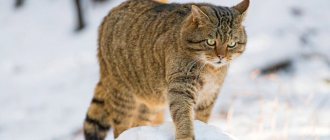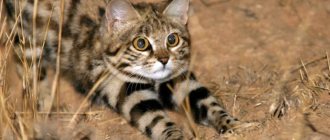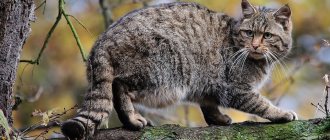Serval - a beautiful predatory animal. People have known this cat for a long time. In Ancient Egypt it protected homes from rodents. For its usefulness, elegant appearance and independent character, the Egyptians made the serval a sacred animal.
Origin story
Africa, as well as partly Egypt, can be considered the homeland of wild Servals. Since ancient times, people began to tame this animal, which is due to its small size. Such cats were especially respected in Egypt due to their hunter's instinct. The appearance of a Serval in some place guaranteed the disappearance of rodents and snakes.
If previously they lived throughout the African continent, now their range has narrowed to the southern continent (mainly Tanzania).
The first mention of the serval dates back to 1765. This was the name of the pet of the Royal Menagerie of Versailles, as the scientist Schreber described in his writings. The unusual nature of the animal was its non-standard size and remarkable color (clear spots and stripes could be seen on a golden background).
The serval is colloquially called the bush cat. The animal owes this nickname to its way of life. Animals try to spend most of their time in dense bushes, hiding from large predators. Also, such camouflage helps to successfully hunt small game.
They prefer to hide in bushes
It was registered as a domestic breed in the 19th century. Since keeping wild pets requires considerable expenses, only wealthy people kept them. Also, a Serval in the house was a sign of good taste, prosperity and greatness of the owner himself. Outwardly, a wild animal is practically no different from a domesticated one, the difference is in habits.
Proper feeding and health of the domestic Serval
In the wild, the Serval hunts and eats small animals: various rodents, hares, hyraxes, as well as birds, even flamingos. Of course, it eats its prey along with the skin, fur, beaks and claws, thus obtaining the minerals necessary for normal life.
At home, you should feed your pet only raw meat, along with bones and skin - the carcasses and heads of any birds, as well as veal, are perfect. Under no circumstances should you cook semi-finished meat products. Boiled meat simply will not be digested by a wild predator, and overcooked bones will be dangerous for the gastrointestinal tract.
To minimize the possibility of contracting intestinal infections, raw meat should be thoroughly frozen and, after defrosting, rinsed with plenty of running water. Sometimes you can include sea or river fish in your diet.
Occasionally it is necessary to give live food - mice, quails, day-old chicks. After such treats, the pet’s mood significantly improves, he becomes especially playful and cheerful.
Do not try to feed your Serval with dry food or canned food. He simply won't eat them. The digestive system of a wild cat does not accept such foods.
African predators, like all cats, must periodically receive grass. To do this, you need to purchase special seeds at the pet store or occasionally offer your pet cabbage and lettuce leaves.
Vitamins such as calcium supplements and taurine are essential for both kittens and adult cats. Raw quail eggs are a wonderful source of calcium; they must be added to the feed along with the shell. Calcium, magnesium, and potassium are especially important for a kitten. The only danger when the Serval is growing up is the fragility of its immature limbs. For the same reason, you should protect your pet from jumping from great heights. Often it is because of the carelessness of the owners that teenage kittens break their paws.
An important source of health for a growing baby is vitamin D. Walking outdoors on a sunny, warm day is the best source of it. In summer, your pet should spend a lot of time in its enclosure.
Otherwise, these cats do not complain about their health. They also tolerate temperature changes quite easily.
Like any cat, the African pet must be dewormed regularly, at least once every three months. Vaccinate against rabies and infections annually. The first vaccination is given at two to three months, followed by revaccination a month later. In the future, servals are vaccinated once a year. Read about vaccination of cats and cats, as well as kittens.
It is strictly not recommended to remove the claws of this animal (the so-called soft paw procedure). This is very painful and will only harm your pet. If your cat's claws are bothersome, you need to trim them yourself, or visit the veterinarian twice a month for these purposes.
Brief description of the breed
| Breed name | Serval (Bush cat) |
| Family | Felines |
| Where does the breed come from? | Africa |
| When did the breed originate? | 1986 |
| Lifespan | 15-20 years |
| Weight of an adult cat | From 9 to 19/from 9 to 12 kg |
| Height | 40-65 cm |
| Body length including tail | 180-185 cm |
| The cost of a purebred kitten | 200-500 thousand rubles. |
Approximate prices
In Russia you can buy a Serval kitten for approximately the following price:
- According to an advertisement submitted on the Internet - from 450,000 rubles .
- In a nursery, from a professional breeder - from 500,000 rubles .
A purebred kitten with a pedigree and all the necessary documents costs about 1,600,000 rubles . A hybrid brood is sold at a price of 630,000 rubles . If the animal costs less than 400,000 rubles, then it is better not to take it: most likely the seller is passing off another, less valuable breed as a serval.
Breed characteristics
A brief description of the Serval breed was compiled based on expert assessments from the website Usatik.ru and reviews from owners. The indicators are average and may not be suitable for an individual representative. Please note that each cat is individual.
| Character trait | Rating on a five-point scale |
| Attitude towards children | 4 |
| Interaction with strangers | 3 |
| Health | 4,5 |
| Playfulness | 5 |
| Intellectual capabilities | 5 |
| Attachment to home and family | 5 |
| Conflict | 0 |
| Difficult to care for | 1,5 |
| Predisposition to shedding | 0,5 |
| Cost of a kitten | 5 |
| The need for constant contact with others | 3 |
| Aggressiveness | 3 |
| Cleanliness | 4 |
| Dimensions | 5 |
| Picky eating | 3 |
Scientific classification
| Kingdom | Animal |
| Family | Felines |
| Subfamily | Small cats |
| Type | Chordata |
| Class | Mammals |
| Subclass | Animals |
| Squad | Predators |
| Infraclass | Placental |
| Genus | Servals |
| View | Bush cat |
| Subspecies | Domestic cat |
Do you want to buy a serval kitten?
Cute representatives of this feline species are constantly pursued by humans. They are illegally caught and destroyed for their beautiful skins. If you like the African Serval cat, buy a purr only from trusted catteries. EkzoticZoo will help you purchase a cat - we cooperate with official organizations involved in breeding exotic animals and birds from Russia, the CIS, and Europe. Future owners are provided with all necessary documents, including Cites. We deliver by pet ourselves, providing comfortable transportation conditions for each individual.
Appearance
Sexually mature Servals are graceful, active animals of fairly substantial size. The breed standard was approved in 2001 and has not changed to this day.
Externally, the cat is similar to a cheetah, but with a shorter tail. But he has the largest ears and long legs that are only found among representatives of the cat family.
Servals can jump very high
Dimensions
Servals are impressive with their size
It's hard to call it a miniature cat. Adult boys weigh about 18-19 kg, girls - about 13 kg. The body length reaches 60 cm (from the shoulder area to the tail) with a height at the withers of 55-65 cm.
Servals are taller than Caracals (their ancestors) with the same body weight.
Anatomy
Anatomical features according to the international standard:
| Body type | Strong, muscular, fit. The body is slightly elongated. |
| Head | Small, triangle shaped. The chin has clear outlines. |
| Limbs | Long, slender, with well-developed muscles. The front legs are apparently shorter than the hind legs. |
| Neck | Elongated, graceful. |
| Ears | Vertically placed, large-scale, close to each other. On the back side there are white stripes, otherwise called “eyes”. It is to them that kittens orient themselves in the dark in order to keep up with the mother cat. |
| Eyes | Medium in size, round in shape, yellowish or greenish in color. |
| Tail | Long, but not particularly thick. Compared to other parts of the body, the fur on it is fluffier. |
| Wool | Short, tough, shiny. It is in close contact with the body. There is no undercoat. |
Colors
The main color of Servals varies from sand to deep copper with dark spots and stripes. The back is darker, but the belly is lighter - from cream to pure white. Each individual has its own pattern regarding the size and location of spots and stripes.
Interesting! Previously, Servals with large and small spots were considered different species. High in the mountains of East Africa live completely black Servals (Melanists), which were also classified as a separate category. But albinos with a silver pattern were bred by breeders.
The spots on the body of the animal are close to a round shape, and closer to the rear they extend vertically and ring the tail. Its tip is completely black. The ears are separated by a white border, and their surface at the back is charcoal.
Character traits
Despite the fact that the Serval cat is a domestic cat, its character is not sweet. Therefore, we must put up with many manifestations and not try to change them abruptly, but still correctly correct them. Otherwise, the pet will feel its power and show itself in all its glory.
By nature, these African cats are timid and rather shy, but extremely active and mischievous. They love to play, run and jump. They cannot be prohibited from doing this, since activity is inherent in them by nature. In the wild world they are accustomed to hunting birds, overtaking them at a height of up to three meters. So domesticated individuals also have this habit.
You must be prepared for the fact that in the process of conquering the peaks, valuable things around the house may suffer (it is better to remove everything in advance).
Carefully! Servals cannot be played with with your hand or foot. This can provoke the animal to attack using its claws and teeth. If the kitten’s bite is not particularly sensitive, then such a lunge from an adult Serval can lead to serious injury. Therefore, during active pastimes, they use special toys for pets.
They are also compared to dogs because of their acutely developed sense of devotion to their owner. In case of danger, the cat will be the first to rush to defense. This also applies to all other family members. But establishing contact with an African native is much more difficult than with an ordinary domestic cat. It takes a lot of effort until the kitten gets used to its owner. But then the efforts will pay off handsomely - you will not find a more faithful friend and companion.
The bush cat is quite a benevolent creature
In general, these cats are quite friendly and extremely inquisitive. There will be no corner in the house that will go unnoticed.
It is worth noting some other features of Serval behavior:
- Feeling danger, the cat tries to run away. If you start to catch up, she will think that they want to harm her. It is wiser to wait until the pet calms down and comes up on its own. You can try to bring him back through gentle persuasion, attracting him with his favorite toy or treat.
- It is unacceptable to leave the Serval alone with children. At this time, you need to stand nearby and control the communication. Since the cat’s ancestors are predators, any encroachment on their person can be perceived as a threat. Then there is a high risk that the animal will show aggression towards the child. Or your pet will develop a fear of children that will remain forever.
If cats are treated with respect and care, they will not offend anyone.
Attitude towards people
Adult cats are distrustful and wary of strangers in the house. At the sight of a stranger, the Serval immediately retreats and hides in some secluded place. Until the guests leave, he will not come out.
On a note! Do not try to forcefully pull the Serval out for display. This will only frighten your pet, which can harm him emotionally. Such actions are fraught for the owner with loss of trust on the part of his pet.
Attitude towards other animals
They get along with other pets without problems. However, at first they need time to get used to them. But then they enjoy playing and running together. Problems can only arise when living next to small pets (birds, hamsters). The cat may mistake them for toys and cause harm.
Nutrition
The serval, also known as the bush cat, is a carnivore. Hunts rodents, small birds, reptiles. Destroys nests and can catch large insects. Does not disdain frogs and other amphibians. Eats grass in small quantities. It serves to improve digestion and cleanse the stomach.
The main prey of the serval are small animals weighing up to 200 grams. That's 90%. The largest share of hunting trophies is occupied by rats. There are attacks on larger prey: hares, young antelopes, flamingos.
When tracking prey, the serval relies primarily on hearing. The hunt consists of two phases. First the serval creeps up, then a sharp lunge follows. The serval in the photo is often captured in an attacking jump.
It (the jump) can be up to 2 meters in height and up to 4 meters in length. Like a domestic cat, it does not play with the victim. The prey is killed immediately and there is a quick transition to the meal. At the same time, internal organs and bird feathers are not eaten.
The bush cat is a skilled hunter. Scientists have calculated that half of its attacks end in the capture of prey. Mother cats have an even higher success rate. It is equal to 62 percent. A cat feeding kittens makes 15-16 successful attacks during the day.
Animal health
Domestic Servals, like wild ones, have good health. They are not characterized by diseases of genetic origin, since different breeds were not involved in the crossing. It is important to constantly monitor your pet’s condition and adhere to safety precautions. Kittens are extremely active. Therefore, until they reach six months (the period of active growth), make sure that they do not jump from great heights. The skeleton, which has not yet formed, is especially susceptible to injury.
Representatives of this breed sometimes experience disturbances in the gastrointestinal tract. If your kitten has persistent diarrhea, do not delay a visit to the veterinarian. Otherwise, dehydration is possible in literally a short period of time.
In general, proper nutrition will guarantee the health and well-being of your pet.
What does the price depend on?
In Russia, a serval can be bought for varying amounts of money. The price is formed under the influence of a number of factors:
- Age of the kitten.
- Purebred.
- Place of purchase.
- Availability of pedigree.
- Coat color, intensity.
- State of health.
- Generation.
- Availability of a veterinary passport.
- Availability of a veterinary card.
Hybrids between a serval and a domestic cat are called Savannahs and are much cheaper than purebreds. Having a veterinary card or passport makes the purchase more expensive. The more intense the color of the animal, the higher its cost will be.
How long do domestic servals live?
In the wild they live for about 12-13 years. But domestic cats, which are properly cared for, provided with a balanced diet and there is no threat from large predators, can easily live up to 20 years.
What to feed a serval
The serval needs to be fed in such a way that it does not even think about yearning for the African savannah. In the wild, most of the predator's diet comes from rodents and birds. The minority consists of snakes, lizards, and insects. Of course, you don’t have to catch grasshoppers for your cat; it’s enough to create the right menu of meat (beef, veal), food mice, rats and poultry. As a compliment from the cook, you can offer the animal quail eggs and offal. Vitamin and mineral supplements must be included in the diet. Water should always be freely available.
Serval breeding
In its natural habitat, the African serval leads a predominantly solitary lifestyle, with the exception of the mating season. Essentially, males are polygamous and their territories are available to an unlimited number of females during mating. Despite the fact that animals do not have a clear interval for reproduction, it most often occurs in the spring. The “bride” begins to court the potential partner, and very patiently. Then comes estrus, which lasts no more than a day.
Breeding in captivity is a complex process and requires a professional approach. The female bears the offspring for 10-11 weeks, resulting in the birth of no more than three kittens weighing about 200 grams. In the first ten days they increase in size almost 2-3 times. Permanent fangs grow by six months. And puberty occurs in the interval of 19-24 months.
For your information! Every breeder who undertakes the breeding of Servals accomplishes a feat. It is believed that these animals do not reproduce in captivity, but in practice this is real. During the mating season, the cat becomes extremely anxious, active and can even injure animals in the neighborhood. There is a high probability that the offspring will be born underdeveloped and will need outside help.
If a mother cat is carrying hybrid babies, then after they appear, she can crush them. The weight of such newborns is no more than 100 grams. It is worth noting that males born from mating Serval with other breeds of cats remain sterile for several subsequent generations.
Reproduction of servals and caring for offspring
global $ads_google;
//data-ad-slot=”2475549904″ $ads_google = empty($ads_google) ? false : true; ?> if ($ads_google == false) {?> $ads_google = true; ?> } ?> Serval cats do not adhere to any boundaries regarding the mating season: on the African continent, tiny kittens are born mainly in late winter and until mid-spring. A female serval carries her cubs for just over two months. There are usually 2-3 babies in one litter. The mother brings them to a nest in the tall grass and feeds them.
At six months, serval kittens begin to hunt on their own, but do not yet refuse their mother’s milk. At 7 months, the female stops feeding them, and they hunt together for up to a year, then the children leave her and go to live completely independently in other territories.
Interesting Facts
Some interesting facts about African cats:
- Their long legs earned them the nickname “giraffe cat.” This structural feature is due to the highly elongated metatarsal bones of the limbs.
- Among all representatives of the cat family, it has the largest ears. They are crescent-shaped, erect, black on the back and have white markings.
- They can easily overcome heights of 3 meters or more. They jump without a run, pushing off with their powerful hind legs.
- Males and females tend to mark their personal territory by spraying urine and rubbing it in with their claws. Males do this more intensely – up to 45 times per hour.
- From time to time there are cat fights. When threatened, the animal looks very intimidating: straightened ears, arched back, bared fangs. At the same time, they constantly shake their heads. When the situation worsens, the animal pounces with its forelimbs and begins to bark and growl.
- They can purr, chirp, hiss, click and make other unusual sounds. Besides that, they are like dogs, they bark.
The name of the cat comes from the Latin word, which means “wolf-deer”.
Myths about the danger of Servals
Domestic Servals are not dangerous to humans if you treat the animal with respect.
Many people are wary of this breed of cat because of common myths about the dangers of keeping them near humans. It is believed that savages cannot be tamed. This is the opinion of those who have not actually interacted with domesticated animals, not aviary animals.
To explain briefly, the domestic Serval cat is no more dangerous than a medium-sized dog. Even in the wild, these animals hunt mainly small animals, and in front of a more formidable opponent they give in and, at most, hiss to intimidate, but do not attack themselves. The exception will be when the mother stands up to protect her offspring. In fact, these are affectionate and friendly creatures, capable of interacting with humans without conflict.
It is also necessary to take into account that Servals do not get along well in families with small children, who perceive the animal as a toy and terrorize it (pulling its tail and ears, shoving it, etc.). They also cannot tolerate loud noises, and children tend to scream. If a child understands how to behave correctly with such a pet, communication problems will not arise.
Advice! When choosing a kitten, pay attention to its behavior. If he aggressively hisses and bites, then obviously in the future he will not become an easy-going cat. It is better to refuse such an instance immediately. It is better to take the baby away from the mother cat when he is 1.5-3 months old.
Home care: care and education
The mandatory conditions for keeping such an unusual pet are:
- Large area of the house, high ceilings. This large cat physically cannot be in a small room. And since it really likes to sleep on high surfaces, an adult animal needs to build a reliable and stable nest at a height of two to three meters. During the day, your pet will happily sleep there.
- The kitten must be kept in a room where there are no high cabinets and shelves where it could jump. In general, you should not leave your baby unattended.
- It is necessary to allocate a separate room for the serval to sleep - preferably a whole room. They are crepuscular animals, they will definitely wake up household members early in the morning and prevent them from falling asleep late in the evening. It is during these hours that their daily activity peaks in the wild. However, you cannot leave your pet alone for a long time. For successful socialization, he must constantly be with people. If guests come, you should also not close him alone - the cat will perceive this as punishment and will be offended.
- There should be an enclosure outside for independent walking in the warm season. This cat, like a dog, loves to walk with its owner on a leash, but on warm summer or spring days, it will happily play in its pen on the street near the house.
- You need to buy at least two large toilet houses for the kitten. For an adult serval, an even larger tray should be provided - at least one meter by sixty centimeters. The baby gets used to the tray quickly, but will definitely use two at once for different needs. In nature, the African cat also always has two places for the toilet.
- You should not scold, much less beat, a serval if it buries excrement under its bedding; most likely the toilet was dirty. These cats will understand perfectly if their mistakes are explained to them in a calm, stern tone.
- You will have to order bedding, houses, and enclosures yourself. Our industry does not produce anything for cats of this size.
- Bowls for water and food should be purchased in large sizes, preferably earthenware or stainless steel.
- Special cat muzzle of the largest size for visiting a veterinary clinic. It not only prevents the cat from opening its mouth, but also closes its eyes. With this device, your pet’s stress level when visiting a doctor is significantly reduced.
- Collar, harness, leash. From a young age it is necessary to accustom the kitten to these accessories, then he will be happy to walk with his owner.
- You will need a large freezer to store food. The serval eats raw meat, and it must be well frozen. It’s even better to have a camera that can freeze at temperatures below minus forty degrees Celsius. This kills almost all pest bacteria in raw meat.
- Special care for the fur, which resembles the color of a leopard, is not required. In summer, it is recommended to place a large container of water in the enclosure; in the heat, the pet will splash around with pleasure.
Owner reviews
Olga: I professionally breed Serval cats. I would like to assure you that these are smart and elegant animals. My students are very smart. They instantly understand commands and execute them. The main thing is to say in a confident but calm voice: walk, lie down, eat, come to me, toilet - and cats do everything the first time. Our Africans do not need a separate place to rest (although they do have beds), since they always go to bed next to us. This breed can be called imperial!
Anastasia: At the beginning, as soon as a kitten appeared in our house, he scared me. He had just turned 5 months old, and the baby hissed and growled incessantly whenever my husband or I tried to approach him. But we were patient and began to establish contact with the savage. As a result, the efforts were crowned with success - the new resident stopped being afraid of us and overreacting. Now this tomboy no longer hides in secluded places, but frolics openly. We often take him on walks together, which brings real pleasure to everyone.
Oleg: We consider Astena (that’s what we named the Serval kitten) to be our child. We constantly pamper her, let her do a lot, and she uses it successfully. Not so long ago, with my own hands, I equipped a large playing town for my pet instead of a house. The complex is multi-level, where the cat can hone his hunting skills to his heart's content. We also take our Asta on trips, where there are no problems with her. She calmly walks nearby on a leash and quickly gets accustomed to another tray.
Andrey: A friend gave me a Serval kitten as a gift. At first I thought it was a small cheetah, it was very similar in appearance. He named him Whiskas. Now he is already a year old. He turned into a graceful animal with long legs - I especially like this feature. By nature, he is very playful, mischievous and extremely active. He is always close to me, we even sleep together.
Antonina: Before getting a cat of this breed, I studied a lot of information and reviews from happy owners. But there were doubts, since it is a predator by nature, and there were concerns, since we have children. But the desire prevailed, and we decided to buy such a pet. Serval has been living in the house for a year now, so far everything is going well with communication. Maybe his character will change with age, but now he is calm and friendly.











